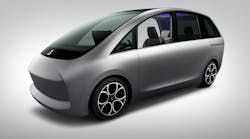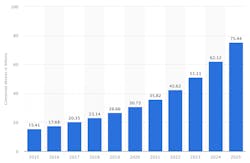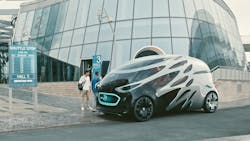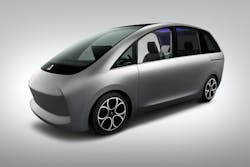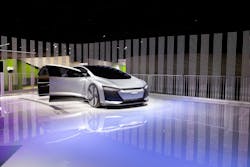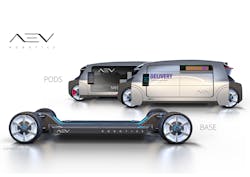Ever since the Internet of Things (IoT) became part of our world, the promise has always been that the number of connected devices would be in the billions. According to Statista.com, by 2025 there will be at least 75 billion devices connected to the internet. In an attempt to help manage those devices, to ensure each one has the required speed and data bandwidth, telecommunication companies and organizations have begun investing in 5G, the new generation of wireless communications.
By 2025, ownership of mobile device will surpass 75 billion. The Consumer Technology Association believes that most of them will be 5G-enabled.
Generations of Wireless Communications
The “G” in 5G means it’s the fifth “generation” of modern wireless technology. Each generation of wireless technology has been defined by either their data transmission speed, encoding methods, or “air interfaces” which make them no longer compatible with the generation before it. The previous generations leading up to 5G can be defined by the following:
- 1G were analog cellular communications.
- 2G were the first digital cellular technologies such as CDMA, GSM, and TDMA.
- 3G were cellular communications that introduced speeds from 200 kbps to a few megabits per second such as EVDO, HSPA, and UMTS.
- 4G were cellular communications that had speeds of hundreds of megabits and even low gigabits per second such as WiMAX and LTE.
5G promises to introduce faster speeds of up to 20 times faster than 4G at a possible 10 to 20 gigabits per second, lower latency to be more responsive to device requests, and the ability to connect multiple devices at once without sacrificing performance. 5G will operate by using a type of encoding called OFDM and run on frequencies below or above 6 GHz.
At higher frequencies, those at 28 GHz and 39 GHz, there is an opportunity to use broad swathes of spectrum to create much larger channels at higher speeds. These higher frequencies are shorter in range than lower frequencies, so smaller and lower-powered base stations will be needed to provide effective coverage.
AT&T will be the first network to launch mobile 5G across 19 cities. It will be using 39 GHz spectrum for the initial deployment, followed by 28 GHz, and then lower-band 5G. Verizon has already launched a fixed 5G home internet service and will follow suit with a 28 GHz mobile 5G network later in 2019. T-Mobile is building its 5G network on the 600 MHz and 28 GHz frequencies in 2019 and plans to offer full national coverage by 2020.
At CES 2019, Nissan demonstrated the future of driving to CES visitors through an interactive, three-dimensional immersion experience at Nissan's display. Invisible-to-Visible, or I2V, is a future technology that helps drivers “see the invisible” by merging both real and virtual worlds, creating the ultimate connected-car experience. I2V will support drivers by merging information from sensors outside and inside the vehicle with data from the cloud. This enables the system not only to track the vehicle's immediate surroundings but also to anticipate what’s ahead, even showing what’s behind a building or around the corner. (Credit: Nissan Motor Corporation)
5G Communications for Self-Driving Cars
While wireless devices and smartphones will receive most of the attention when it comes to developing 5G, the communication protocols for vehicles will be impacted significantly and usher in a new era of car-to-car communications.
Cellular-V2X (vehicle-to-everything) is a developing communication platform that leverages LTE and, in the future, 5G communications. C-V2X provides an integrated solution for vehicle-to-vehicle (V2V), vehicle-to-infrastructure (V2I), and vehicle-to-network (V2N) using cellular networks.
5G Automotive Association (5GAA) is a global cross-industry organization of companies from the automotive, technology, and telecommunications industries working together to develop end-to-end solutions for future mobility and transportation services. It was created in 2016 and the association includes over 100 members whose mission is to develop, test and promote communications solutions for vehicles.
With Vision URBANETIC Mercedes-Benz developed a mobility concept that embedded within an intelligent, self-learning IT infrastructure. The system architecture of the autonomous Vision URBANETIC ensures continual route adaptation using real-time traffic information. (Credit: Mercedes-Benz)
According to 5GAA, “C-V2X technology is set to revolutionize the mobility ecosystem and the way drivers interact with the world. It is essential to redefining transportation by providing real-time, highly reliable, and actionable information flows to enable safety, mobility, and environmental applications…C-V2X will be key to achieving the level of connectivity required for V2X communication, and it is set to be a disruptive force in the automotive market.” C-V2X is currently undergoing validation testing in several markets. The 5GAA reports that 13 trials are currently being implemented, including nine in Europe.
At CES 2019, C-V2X was selected as this year’s Innovation Award Honoree in the “Vehicle Intelligence and Self-Driving Technology” category. On stage at CES, 47 members of the 5GAA announced various advancements in C-V2X. Ericsson showcased how C-V2X will use mobile 4G and 5G networks to enable safety services for connected and self-driving vehicles.
Samsung with HARMAN demonstrated their scalable 5G Telematics module for wide-scale C-V2X communications. Veniam and Bosch showcase their jointly developed all-in-one central control unit for V2X data management and communication to move massive amounts of data from and between vehicles.
Aisin, in partnership with Toyota, has developed two self-driving vehicles that debuted at CES 2019. One is an automated passenger car (shown here) and the other is an automated limousine. (Credit: Aisin)
Some major announcements came from Qualcomm and Ford Motor. Qualcomm promised that more than 30 5G devices will be powered by its Snapdragon 844 mobile chips and X50 5G cellular modem in 2019. Qualcomm has been working on 5G technology for several years now and claims to have determined how to manage sub-6 GHz and higher millimeter wave wireless signals. At the Society of Automotive Engineers Connect2Car conference session, Qualcomm drove the discussion on 5G with the support of major car manufacturers such as Audi, Ducati, and Ford.
Ford at CES announced that starting in 2022, all of its U.S. models will be C-V2X enabled, allowing them to communicate with other vehicles and infrastructure. The move is seen as a game-changer since U.S. regulators have yet to greenlight C-V2X. The government has invested heavily into direct short-range communications (DSRC), the competing Wi-Fi technology. This standard has been adopted by Toyota and General Motors. DSRC would require that governments spend billions to create new infrastructure and antennas to create a large enough DSRC spectrum just for vehicles.
According to Don Butler, executive director of Ford’s connected-vehicle platform, choosing C-V2X over DSRC was calculated decision. Butler and Ford’s point of view is that since telecommunication companies are already spending a substantial amount to upgrade their networks to 5G, adopting 5G for the car industry is the easiest and fastest solution.
DENSO Urban Moves features automated driving and connected technology as part of its long-term commitment to help create the future of mobility. The technologies being displayed in their new shared ride service are cybersecurity applications to cloud technology connecting vehicles to outside networks and carsharing features. (Credit: Denso)
The Future of 5G Networks
To get an understanding of 5G networks and how they will evolve around the world, I spoke to Steve Koenig, vice president of research at the Consumer Technology Association, which organizes CES. According to Koenig, every 10 years we see a new development of wireless technology, and 5G is arriving right on time. For the new IoT data age, 5G and artificial intelligence will be key to power the next age of consumer technology. “We’re seeing the first commercial deployments of 5G in the U.S., South Korea, and China,” Koening notes.” 2019 I think really represents—very similar to like a child learning to walk—5G is taking its first steps, and in a matter of months it will be running all over the house.”
The next steps required to deploy 5G networks will be government regulation, telecommunication deployments, and an increase in spectrum. 3GPP will be releasing a new version of its radio standard, version 16, which will describe the new radio base standard of 5G. Also, an increase of spectrum will be needed to accommodate 5G.
“Countries need spectrum and the fullest expression of 5G operates across a low-, mid-, and high-band,” said Koenig. “The higher band range, either the 28 or 39 GHz range being used by telecommunications, is known as millimeter wave, and that is the new hot topic within 5G and spectrum coverage.”
The Audi Aicon is a new luxury four door sedan that is also an autonomous vehicle. The Audi Aicon achieves between 700 and 800 kilometers (435.0 − 497.1 mi) on a single charge due to its lightweight construction of the multi-material body and optimized aerodynamics. (Credit: Audi)
“The way 5G is structured across these three bands, it’s going to take different antennas and transceivers,” he continues. ‘You’ll have very small cells, steerable antennas, and beam forming, which all relates to a millimeter wave.”
At present, it is easier to predict the path for smartphones to adopt 5G. According to Koenig, the CTA believes that 5G mobile device production will increase quickly over the next six years. While there are a limited number of 5G handsets forecasted for deployment this year, there will be a drastic increase in 2020. By 2021, 40% of all smartphone and wireless devices will be 5G enabled. In 2022, that number jumps to 74%. By 2025 the market will reach 100% saturation of 5G technology.
For cars to connect to 5G networks, the universal standard or standards must first be established. Besides adopting a 5G communications standard, deciding where the data is stored and what rules do car manufacturers need to follow. The National Highway Traffic Safety Administration (NHTSA) only sent out a request for comment on C-V2X last December. According to the request, the Department of Transportation intends to maintain the priority use of 5.9 GHz for spectrum transportation safety communications.
AEV Robotics announced their Modular Vehicle System (MVS) at CES 2019. The foundation of every MVS is a robotic base that is controlled via a programmable interface. Each base is lightweight, electric, features four-wheel steering, and is multidirectional. (Credit: Thomas Hamilton/AEV)
NHTSA wants to know from companies and organizations leading the 5G charge on how “current and future communications technologies that could be associated with the connected vehicle environment, and how these developments affect both V2X deployment and DOT’s role in encouraging the integration of V2X into the transportation environment.” Several car companies have placed their bets in either C-V2X or DSRC camps.
Just like the standard battles of past (BETA vs. VHS, Blu-Ray vs. HD-DVD, etc.), only time will tell who will win. Coming out of CES and the fact that several telecommunication companies have thrown their hat in the ring behind 5G, the odds favor C-V2X to emerge the winner…for now.
